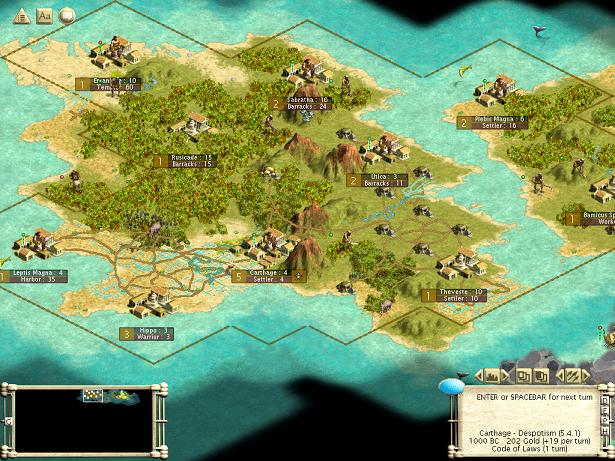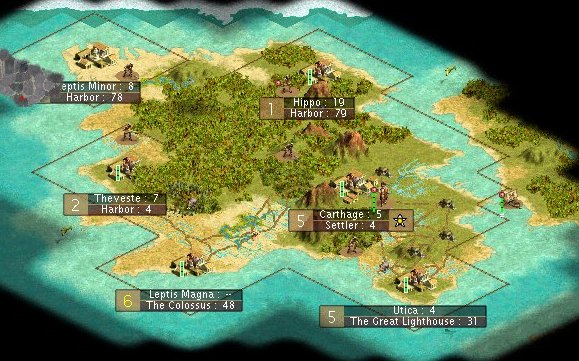4000bc. Worker moves to mountain and sees fertile valley to the west. Consider moving east OR west
I would actually spend the 2 turns and move west, but I seem to experience a lot of disease next to those flood plains. I decide to move east.
3950bc. Move worker east to bonus grassland. Found Carthage.
3900bc. Worker starts on mine. Start researching Pottery on the way to MapMaking. Wow, the game is REALLY slow.
3750bc. Complete mine, start road.
3700bc. Complete warrior, start settler. Warrior S.
3650bc. Warrior south. Worker completes road, moves E.
3600bc. Start road. (Meant to start mine, but hit wrong button.). Warrior west.
3550bc. Warrior NW.
3500bc. Warrior W. Complete road, start mine.
3450bc. Warrior W. Carthage expands.
3400bc. Warrior N. Research to 10%, pottery due in 1 turn.
3350bc. Complete Pottery, start on Writing. Switch Carthage from settler to Granary. Granary due in 7 turns, Carthage grows in 8 turns. Warrior N. Worker W SW to jungle.
3300bc. Worker starts road. Warrior N. It looks like we ARE on an island by ourselves.
3250bc. Warrior N.
3200bc. Warrior N to hill next to river.
3150bc. Warrior E.
3100bc. Warrior E.
3050bc. Warrior S. Worker E NE to bonus grassland.
3000bc. Worker starts mine. Warrior W. Complete Granary, start Settler.
2950bc. Carthage expands to 3. Luxuries to 10%, adds 3 turns to research of Writing. Settler due in 5, Carthage will grow in 5. Nice! Worker W.
2900bc. Warrior W. Find poison gas cloud off the coast.
2850bc. Warrior S. Worker completes mine, starts road.
2800bc. Warrior S.
2750bc. Warrior S. Settler built, start on settler. Settler moves SW SW W. Worker completes road, moves S.
2710bc. Builds Uticia, starts on Worker. Worker moves to Uticia then SW to wheat. Warrior SW.
2670bc. Worker starts irrigation. Warrior moves S.
2630bc. Warrior W, heads for hills at far south peninsula of island.
2510bc. Carthage builds Settler, starts warrior. Settler south. Worker moves to join settler 1 tile S of Carthage.
2470bc. Uticia builds worker, starts warrior. Worker moves E N to hills. Worker 1 starts road. Settler S, warrior SE.
2430bc. Worker2 starts mine. Settler S. Warrior moves west to explore the last tip of the SW peninsula.
2390bc. Worker1 completes road, moves S. Found Leptis Magna, start Granary as prebuild for Great Lighthouse.
2350bc. Carthage builds warrior (fortifies), starts settler. Worker1 starts road. Warrior1 reaches peninsula tip and discovers that we shouldnt expect contact from that direction. The coastal waters end.
2310bc. Research to 50%, writing due in 2 turns.
2230bc. Complete Writing, start on MapMaking, due in 24 turns. Uticia completes warrior (fortifies), starts on settler. Warrior1 on way to Leptis Magna to fortify. Worker1 NE.
2190bc. Worker2 completes mine, starts road. Worker1 starts mine. Warrior1 fortifies. I now have 3 warriors, 1 fortified in each city. Carthage switches to barracks from settler to let the city grow a little more than to size 3.
2070bc. Worker1 completes mine, starts road. Worker2 completes road, moves W.
2030bc. Worker2 starts road. Carthage completes barracks, will build 2 warriors and then a settler.
1990bc. Worker1 completes road, moves to ivory SW.
1950bc. Worker1 starts road. Carthage builds warrior.
1910bc. Worker2 completes road, moves SW.
1870bc. Worker2 starts road. Carthage builds warrior (moves to Uticia), starts settler. Leptis Magna switches to Palace as prebuild for Lighthouse.
1830bc. Worker1 completes ivory road. Moves to hills to start mine. Uticia completes settler, starts Granary. Setter with 1 warrior heads 1 tile W of wheat to found new city.
1750bc. Theveste founded. Worker2 completes road, moves W.
1725bc. Carthage builds settler (heads north) and starts another. Worker2 starts road north of Theveste. MapMaking due in 8 turns.
1675bc. Worker2 completes road, moves E and starts irrigation.
1650bc. Worker1 completes mine, moves north of Carthage.
1625bc. Worker1 moves to coastal jungle. Hippo founded on north coast. Whales will be in reach when city expands.
1600bc. Worker1 starts to chop coastal jungle. Research to 70%, MapMaking due in 2 turns.
1550bc. Complete MapMaking, start on Philosophy (8 turns @ 80%) on the way to Replublic. Worker2 completes road, moves S E. Carthage switches to Galley which has been prebuilt.
1525bc. Worker2 starts road. Galley drops a warrior on our neighboring island. The Galley discovers poison gas clouds which we will attempt to sail through
1500bc. Scouting Warrior moves north towards hill. Galley fights through a poison gas cloud, but can only attack once per turn.
1475bc. Galley breaks through to disover another island southwest of the first we found. A third island seems to be visible to the northwest. Warrior moves to hills to get a better look at the smoking volcano we have discovered.
1450bc. Warrior defeats the volcano, and rescues to eqWorkers! Nice surprise!!! Uticia builds granary, starts on settler.
1400bc. Leptis Magna can produce Lighthouse in 45 turns, or build the prebuilt harbor next turn. Carthage can build Lighthouse in 33 turns. I start Lighthouse in Carthage and will turn LM into a Galley factory. Uticia is shaping up as a settler factory for now.
1375bc. LM builds harbor, will put out 1 galley every 6 turns. Our warrior clears some gas (excuse me) and becomes a Veteran.
1350bc. I research Philosophy (lost some $ forgetting to drop research the last turn) and start on Code of Laws (due in 10 with -$2 per turn). Hippo builds a warrior and starts on a worker.
1300bc. Uticia builds settler, starts another. Worker2 finishes mine and starts road next to The. Worker1 chops jungle, starts road. Warrior completes clearing of island 2. Settler will board galley next turn and move there.
1250bc. Found Leptis Minor on new island just north of hills which eqWorkers have mined. They started the road last turn. LM starts Harbor. Worker1 completes road and moves SW to put a road on the grassland LM can see. Worker2 starts second ivory road.
1225bc. LMagna builds galley. Galley1 picks up exploring warrior to move to SW island.
1175bc. My galley sees the outline of what I guess is Egypt on the island to the far west of what I have discovered. Can I communicate with someone else if I can see their units but dont have a land unit? We will find out.
1150bc. Uticia builds settler.
1100bc. I complete Code of Laws and start on Republic (due in 28 at +$2 per turn).
1075bc. I pack a settler and a warrior onto a new galley from LMagna and send it to the island SW of me. I pop a goody hut near the Egyptian border, but get nothing except barbarians. My warrior dies during the barbarian turn.
1025bc. The warrior on the 3rd island approaches the barbarian camp. Inside I find the barbarians, A Elite Mt. Vesuvius, A PhilMartin and A Ainwood. Looks bad for my little warrior. The good news is I am able to make contact with Egypt. I can trade them Writing for Ceremonial Burial, The Wheel, Territory Map and $8. They have a modest empire of 5 cities. Im curious as to how Egypt has a city on a tiny island, since they clearly dont have Map Making.
1000bc. My warrior kills the barb camp, but under it finds
a volcano! Forgot about the Squids. One of my galleys just survived an attack. Ill have to be careful.
975bc. Sabratha founded on island 3. I have to clear the gas before I can start farming the wheat resource.
750bc. Rusicade founded on the far island, just west of Egypt. We are up to 8 cities, and our citizens are asking for the Forbidden Palace.
710bc. Poped another hut, got 2 more barbarians
The Republic is due in 7, as is the Lighthouse.
650bc. England has built The Colussus.
610bc. I conquer another volcano and get 2 more eqWorkers to go help at Rusicade.
590bc. Republic due next turn.
570bc. I discover Republic and revolt. I get lucky and draw only 1 turn of anarchy! Before the revolt I could earn $32 gpt on 100% taxes. Research will begin on Mathmatics then Currency.
550bc. I enter the Republic! After the revolt, I can earn $48 gpt. I set research on 5 turns for Math, with +$4 per turn.
530bc. Carthage builds the Great Lighthouse. Lets see if the extra movement can reveal any additional land surrounding our island chain.
470bc. Egypt declared war on us. Im not really prepared at all. It shouldnt take too long to get up to speed though.
450bc. I discover Mathmatics, start on Warrior Code. Ill go for Archers as the quickest unit to get and produce. I dont really want to wait to discover Bronze Working AND Iron Working, then upgrade all my warriors, assuming I have iron right now.
390bc. Lost my second Galley trying to kill 1 Egyptian galley. Ive lost a Veteran and Regular galley vs his regular galley, and Ive scored only 1 hit. Frustrating.
370bc. Founded Oea on the northwestern coast of Carthage.
350bc. I recapture Rusicade, losing one warrior in the process.
310bc. I pillage the Horses on Egypts island. However they have archers, who kill my warriors in a counter attack. Maybe Ill have to build spearmen to take Egypt out? Until I can get a good troop of archers though, Ill try to do some random pillaging of Egypt to reduce their production ability.
210bc. Egypt recaptures Rusicade destroying it, due to my galleys terrible war record. Unless Im really confused, galleys both attack AND defend at a 1. So Ive lost 4 galleys so far, and sunk only 1 in return. Im also starting to experience war weariness. Great!
150bc. The Zulu build The Oracle.
50ad. I finally capture my first city, Thebes. Ive starved it down to a size 1, so hopefully I wont have any city flipping.
150ad. Heliopolis falls to my troops.
170ad. China completes the Great Pyramid. Persia completes the Great Library. Aztecs complete the Great Wall.
210ad. Mephis falls.
230ad. Alexandria falls. Egypt down to 1 city.
280ad. I launch 2 galleys out into the unknown. Ive explored every square inch of ocean I can reach without risking a galley, so now I will start running suicide galley runs to see if I can reach any other land. One survives the following turn, exploring the ocean far south of Alexandria, but finds nothing.
300ad. Elphantine falls. The Egyptians established a last minute city on the next isle east, so Ill have to take that out also. It is destroyed this turn and the Egyptians are history. Now to find some more land!
Ill have to sign off now, because I make contact in the next 2 turns.


 It matters not as all my cows are kicking me. I need some udder manipulation education.
It matters not as all my cows are kicking me. I need some udder manipulation education.
 Mine isn't going as we had discussed in the pre-game conversation. Those far away civs were able to beat me on finishing most of the early Wonders. Other than the Great Chapel, I didn't get nothing else.
Mine isn't going as we had discussed in the pre-game conversation. Those far away civs were able to beat me on finishing most of the early Wonders. Other than the Great Chapel, I didn't get nothing else.


